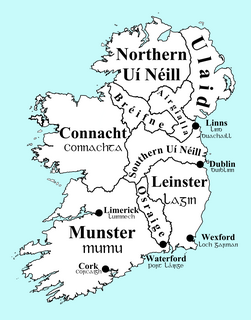Dúngal Eilni mac Scandail (died 681) was a Dál nAraidi king of the Cruthin. He ascended to this position some time after 668. [1] He was the son of Scandal mac Bécce (died 646), a previous king. [2]

Dál nAraidi or Dál Araide was a Cruthin kingdom, or possibly a confederation of Cruthin tribes, in north-eastern Ireland during the Middle Ages. It was part of the over-kingdom of Ulaid, and its kings often contended with the Dál Fiatach for the over-kingship of the province. At its greatest extent, the borders of Dál nAraidi roughly match those of County Antrim, and they seem to occupy the same area as the earlier Robogdii of Ptolemy's Geography, a region shared with Dál Riata. Their capital was Ráth Mór outside Antrim, and their eponymous ancestor is claimed as being Fiachu Araide.
The Cruthin were a people of early medieval Ireland. Their heartland was in Ulster and included parts of the present-day counties of Antrim, Down and Londonderry. They are also said to have lived in parts of Leinster and Connacht. Their name is the Irish equivalent of Priteni, an ancient name for the Celtic Britons, and was sometimes used to refer to the Picts. However, there is a debate among scholars as to the relationship of the Cruthin with the Britons and Picts.
Scandal mac Bécce was a Dal nAraide king of the Cruithne in Ulaid (Ulster). He was the grandson of Fiachra Cáech, the brother of Fiachnae mac Báetáin, a king of all Ulaid.
Contents
In the 6th and 7th centuries the Dál nAraidi were part of a confederation of Cruthin tribes in Ulaid, an over-kingdom in Ireland, and were the dominant dynasty. [3] Dungal belonged to a branch of this family settled in Eilne, a plain between the Bann and Bush rivers in modern-day County Antrim, Northern Ireland. He is styled "King of the Cruithne" in the annals.
Eilne, also spelt as Eilni, alias Mag nEilne, was a medieval Irish Cruthin petty-kingdom in the over-kingdom of Ulaid. It lay between the River Bann and River Bush, and was centered on Magh nEilne, the "plain of Eilne", spanning north-east County Londonderry and north-west County Antrim, in present-day Northern Ireland. Eilne may represent the name of an original population grouping, though even in the Old Irish period who they were was forgotten.

County Antrim is one of six counties that form Northern Ireland. Adjoined to the north-east shore of Lough Neagh, the county covers an area of 3,046 square kilometres (1,176 sq mi) and has a population of about 618,000. County Antrim has a population density of 203 people per square kilometre or 526 people per square mile. It is also one of the thirty-two traditional counties of Ireland, as well as part of the historic province of Ulster.

Northern Ireland is a part of the United Kingdom in the north-east of the island of Ireland, variously described as a country, province or region. Northern Ireland shares a border to the south and west with the Republic of Ireland. In 2011, its population was 1,810,863, constituting about 30% of the island's total population and about 3% of the UK's population. Established by the Northern Ireland Act 1998 as part of the Good Friday Agreement, the Northern Ireland Assembly holds responsibility for a range of devolved policy matters, while other areas are reserved for the British government. Northern Ireland co-operates with the Republic of Ireland in some areas, and the Agreement granted the Republic the ability to "put forward views and proposals" with "determined efforts to resolve disagreements between the two governments".
In 681 he and Cenn Fáelad mac Suibne, chief of Cianachta Glenn Geimin were defeated by Máel Dúin mac Máele Fithrich (died 681) of the Cenél nEógan at what was called the burning of the kings at Dún Ceithirn (in barony of Coleraine, in modern County Londonderry). [4]
Máel Dúin mac Máele Fithrich was a King of Ailech and head of the Cenél nEógain branch of the northern Uí Néill. He had married Cacht ingen Cellaig, daughter of the high king Cellach mac Máele Coba of the Cenél Conaill and their son Fergal mac Máele Dúin was high king of Ireland.
His sons Ailill mac Dúngaile Eilni (died 690) and Cú Chuarán mac Dúngail Eilni (died 708) would also become chiefs of the Dál nAraidi. Cú Chuarán was king of all Ulaid as well. Dúngal also had another son, Fiachra Cossalach (died 710), who was a Dál nAraidi king of the Cruthin, who ruled from 709-710. [5]
Aillil mac Dúngaile Eilni was a Dál nAraidi king of the Cruthin in Ulaid, an over-kingdom in medieval Ireland. He was the son of Dúngal Eilni mac Scandail, a previous king. He ruled from 682-690.
Cú Chuarán mac Dúngaile was a Dál nAraidi king of Ulaid, an over-kingdom in medieval Ireland. He was the son of Dúngal Eilni mac Scandail and brother of Ailill mac Dúngaile Eilni, previous kings of Dál nAraidi
Fiachra Cossalach was a Dál nAraidi king of the Cruthin in Ulaid, a medieval over-kingdom in Ireland. He ruled from 709-710.

